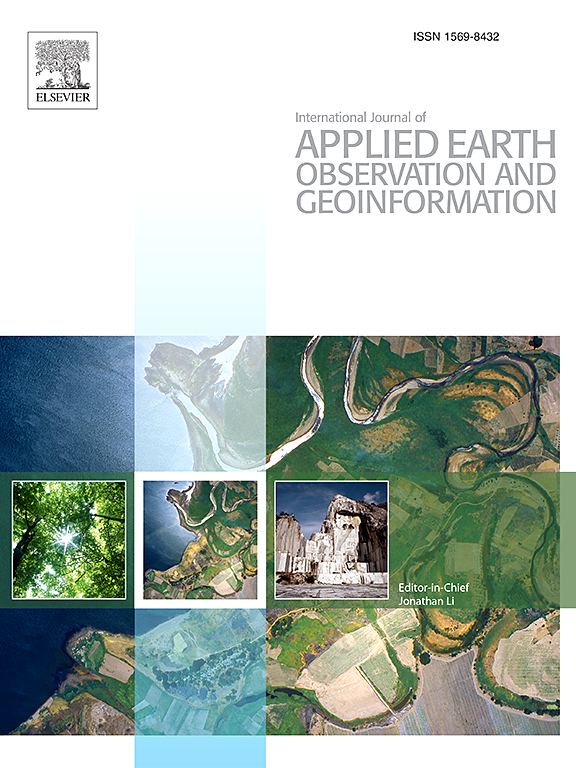SFD-YOLO:基于大尺度SAR干涉图的中国沉降漏斗探测新框架
IF 7.6
Q1 REMOTE SENSING
International journal of applied earth observation and geoinformation : ITC journal
Pub Date : 2025-05-19
DOI:10.1016/j.jag.2025.104605
引用次数: 0
摘要
塌陷漏斗的准确识别对矿区地表变形评估、灾害预防和资源优化管理具有重要意义。然而,在大尺度干涉图中识别不同尺寸的下沉漏斗是一个重大挑战,特别是对于小尺寸的漏斗。它们的模糊特征和对背景噪声干扰的敏感性往往导致检测精度不理想。为了解决这些挑战,本研究提出了一种基于YOLO架构的深度学习网络——sfd -YOLO(下沉漏斗检测-YOLO)。该模型结合DWR-C2f模块,增强了多尺度特征提取能力,显著提高了对小型沉陷漏斗的检测能力。此外,创新的Inner-WIoU回归损失函数提高了检测盒的定位精度,同时也缓解了硬样本和易样本之间的不平衡。实验结果表明,经过充分训练的SFD-YOLO模型在保持高效率的同时,mAP50准确率达到92.00%,明显优于其他先进方法。将SFD-YOLO模型应用于中国各地的干涉图中,共探测到3842个下沉漏斗,其中山西、内蒙古、陕西和安徽是漏斗数量最多的4个省份。总体而言,沉降漏斗主要分布在华北和西北地区。进一步的分析和实验评估表明,SFD-YOLO模型在全国复杂地表环境和多源卫星数据中具有较强的泛化能力。本文章由计算机程序翻译,如有差异,请以英文原文为准。
SFD-YOLO: A novel framework for subsidence funnels detection in China based on large-scale SAR interferograms
Accurate identification of subsidence funnels is essential for assessing surface deformation in mining areas, preventing disasters, and optimizing resource management. However, recognizing subsidence funnels of varying sizes in large-scale interferograms poses significant challenges, particularly for small-sized funnels. Their indistinct features and susceptibility to background noise interference often result in suboptimal detection accuracy. To address these challenges, this study proposes a deep learning network based on the YOLO architecture—SFD-YOLO (Sinking Funnel Detection-YOLO). The model incorporates the DWR-C2f module, which enhances multi-scale feature extraction and significantly improves the detection of small-sized subsidence funnels. Additionally, the innovative Inner-WIoU regression loss function improves the localization accuracy of detection boxes while also alleviates the imbalance between hard and easy samples. Experimental results demonstrate that the fully trained SFD-YOLO model achieves an mAP50 accuracy of 92.00% while maintaining high efficiency, significantly outperforming other advanced methods. Applying the SFD-YOLO model to interferograms across China detected a total of 3,842 subsidence funnels, with Shanxi, Inner Mongolia, Shaanxi, and Anhui identified as the four provinces with the highest funnel number. Overall, subsidence funnels are predominantly distributed in northern and northwestern China. Further analysis and experimental evaluation reveal that the SFD-YOLO model exhibits strong generalization capabilities across complex surface environments nationwide and multi-source satellite data.
求助全文
通过发布文献求助,成功后即可免费获取论文全文。
去求助
来源期刊

International journal of applied earth observation and geoinformation : ITC journal
Global and Planetary Change, Management, Monitoring, Policy and Law, Earth-Surface Processes, Computers in Earth Sciences
CiteScore
12.00
自引率
0.00%
发文量
0
审稿时长
77 days
期刊介绍:
The International Journal of Applied Earth Observation and Geoinformation publishes original papers that utilize earth observation data for natural resource and environmental inventory and management. These data primarily originate from remote sensing platforms, including satellites and aircraft, supplemented by surface and subsurface measurements. Addressing natural resources such as forests, agricultural land, soils, and water, as well as environmental concerns like biodiversity, land degradation, and hazards, the journal explores conceptual and data-driven approaches. It covers geoinformation themes like capturing, databasing, visualization, interpretation, data quality, and spatial uncertainty.
 求助内容:
求助内容: 应助结果提醒方式:
应助结果提醒方式:


